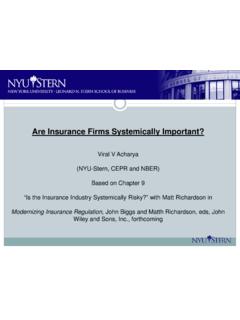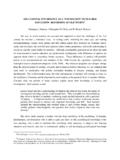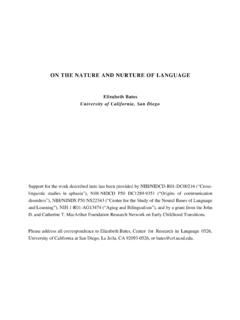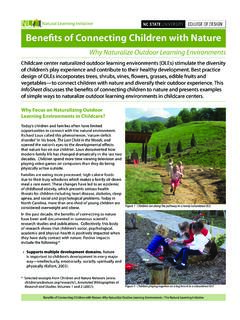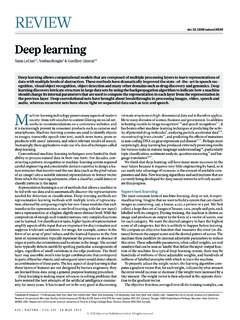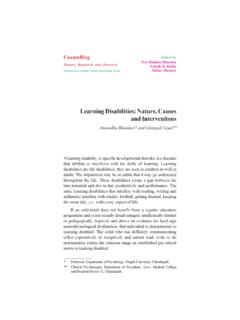Transcription of Nature or Nurture? Learning and the Geography of …
1 Nature or Nurture? Learning and the Geography of Female LaborForce ParticipationAlessandra Fogli University of Minnesotaand CEPRL aura VeldkampNYU Stern School of Businessand NBERM arch 12, 2010 AbstractOne of the most dramatic economic transformations of the past century has been the entryof women into the labor force. While many theories explain why this change took place, we in-vestigate the process of transition itself. We argue that local information transmission generateschanges in participation that are geographically heterogeneous, locally correlated and smoothin the aggregate, just like those observed in our data. In our model, women learn about theeffects of maternal employment on children by observing nearbyemployedwomen. When fewwomen participate in the labor force, data is scarce and participation rises slowly. As informa-tion accumulates in some regions, the effects of maternal employment become less uncertain,and more women in that region participate.
2 Learning accelerates, labor force participation risesfaster, and regional participation rates diverge. Eventually, information diffuses throughout theeconomy, beliefs converge to the truth, participation flattens out and regions become more sim-ilar again. To investigate the empirical relevance of our theory, we use a new county-level dataset to compare our calibrated model to the time-series and geographic patterns of participation. Corresponding author: 44 West Fourth St., suite 7-77, New York, NY 10012, tel:(212)998-0527. We thank seminar participants at Northwestern, the World Bank, Chicago GSB, Wisconsin Madison,Minneapolis Federal Reserve, Princeton, European University in Florence, University of Southern California, NewYork University, Boston University, Bocconi, Pompeu Fabra, Ente Einaudi, Boston Federal Reserve and HarvardUniversity and conference participants at the 2009 winter NBER EF&G meetings, 2008 AEA, SITE, the 2007 NBERS ummer Institute, the SED conference, LAEF Households, Gender and Fertility conference, the NBER group onMacroeconomics across Time and Space, Midwest Macro Meetings, the NY/Philadelphia Workshop on QuantitativeMacro, IZA/SOLE and Ammersee.
3 We especially thank Stefania Marcassa for excellent research assistance andStefania Albanesi, Roland Benabou, Raquel Bernal, Jason Faberman, Jeremy Greenwood, Luigi Guiso, Larry Jones,Patrick Kehoe, Narayana Kocherlakota, Ellen McGrattan, Fabrizio Perri, Harald Uhlig and our anonymous refereesfor comments and suggestions. Laura Veldkamp thanks Princeton University for their hospitality and financialsupport through the Kenen fellowship. Keywords: female labor force participation, information diffusion, economicgeography. JEL codes: E2, N32, R1, the twentieth century, there has been a dramatic rise in female labor force participation inthe United States. Many theories of this phenomenon have been proposed. Some of them emphasizethe role played by market prices and technological factors; others focus on the role played by policiesand institutions, and a few recent ones investigate the role of cultural factors.
4 All of them, however,focus on aggregate shocks that explain why the transition took place and abstract from the localinteractions that could explain how the transition took use new data and theory to argue that women s labor force participation decisions relyon information that is transmitted from one woman to another, located nearby. The local natureof information transmission smooths the effects of changes in the environment and generates ge-ographically heterogeneous, but locally correlated reactions, like those observed in our data. Ourtheory focuses on Learning and participation of married women with young children, because thissub-group is responsible for most of the rise in participation. A crucial factor in mothers participa-tion decisions is the effect of employment on their children. However, this effect is uncertain. Theuncertainty makes risk-averse women less likely to participate.
5 Learning resolves their uncertainty,causing participation to our overlapping generations model, women learn from their neighbors about the relativeimportance of Nature (innate ability) and nurture (the role of maternal employment) in determin-ing children s outcomes (section1). Women inherit their parents beliefs and update them afterobserving the outcomes of neighboring women in the previous generation. Those outcomes revealinformation about the effect of maternal employment only if the neighboring mothers were em-ployed. Section2shows that higher local participation generates more information, which reducesuncertainty about the effect of maternal employment and makes participation of nearby womenmore likely. Thus, local participation snowballs and a gradual, but geographically-concentratedrise in participation rates county-level data from 1940-2000, section3documents how the growth rate ofwomen s labor force varied over time and across the shift from an agricultural to1To our knowledge this county-level Historical, Demographic, Economic and Social Data has not been exploredbefore in economics economy separated the location of home and work, the female labor force grew slowly upthrough the post-war decades, accelerated during the 1970s and 1980s, and recently flattened , this growth was uneven across geographic regions: High participation rates emergedfirst in a few geographic centers and spread from there to nearby regions, over the course of severaldecades.
6 This process gave rise to significant spatial correlation across the participation rates ofUS counties that is only marginally explained by common economic and demographic factors. Thisresidual correlation slowly rose at the beginning of the period, peaked when aggregate labor forceincreased fastest and finally declined as aggregate labor force moments of the labor force participation distribution across US countiesin 1940 to calibrate and simulate a dynamic Learning model and explore its quantitative results are consistent with the S-shaped evolution of aggregate labor force, and the rise andfall in the spatial correlation of county-level participation rates. The model generates S-shaped dy-namics because initially, when uncertainty is high, very few women participate in the labor market;information about the role of nurture diffuses slowly and beliefs are nearly constant.
7 As informa-tion accumulates and the effects of labor force participation become less uncertain, more womenparticipate, Learning accelerates and labor force participation rises more quickly. As uncertainty isresolved, beliefs converge to the truth, and participation flattens local Nature of the Learning process generates the rise and fall of spatial correlation inparticipation. Initially, female labor force participation is low everywhere and the minute differencesare spatially uncorrelated. As women in some locations start working, their neighbors observe themand learn from them. Learning makes the neighbors more likely to work in the next generation,generating an increase in geographic heterogeneity and spatial correlation. Eventually as the truthabout maternal employment is learned everywhere, heterogeneity and spatial correlation in localparticipation rates falls. Section6extends these results to a setting with multiple types of model provides a simple framework for examining the transition dynamics and geographyof a wide array of social and economic phenomena.
8 Section7concludes by describing furtherextensions of the model that could capture other social and cultural to other theoriesMany recent papers have explored the rise in female laborforce participation. Among these theories, some focus on changes that affect the costs or benefitsof employment for all women: changes in wages, less discrimination, the introduction of householdappliances, the less physical Nature of jobs, or the ability to control contrast, our theoryfocuses on why the participation of women with children rose so much faster than the aggregateparticipation rate. A complete understanding of the rise in participation requires both pieces, anexplanation of what changed for all women and what made married mothers behave so group of theories shares our focus on changes that affect mothers specifically, but un-like our theory, rely on aggregate shocks. For example, the decline in child care costs, medicalinnovation, or public news shocks are changes that spread quickly because there are no geographicbarriers or distance-related frictions causing some regions to be , one canmodify these theories to introduce geographic heterogeneity by adding income or preference is harder to explain is why the participation transition happened at differenttimes in different places.
9 The rates of change in participation were vastly different across counties,resulting in a rise and then a fall in the cross-county dispersion of participation rates. This is nota pattern that a typical aggregate shock would would think that any local coordination motive ( social pressure) or thick marketexternality ( child care markets) could generate local differences in the speed of such a coordination model typically predicts a simultaneous switch from a low-participationto a high-participation outcome, unless there is some friction preventing perfect coordination. Ourlocal information externality generates locally correlated behavior, while the imperfect Nature ofthe information is the friction that prevents perfect economy-wide third strand of related literature studies the Geography of technology diffusion. While it does2 See Greenwood, Seshadri, and Yorukoglu (2005), Goldin and Katz (2002), and Goldin (1990), Jones, Manuelli,and McGrattan (2003) on Nature of Attanasio, Low, and Sanchez-Marcos (2008) and Del Boca and Vuri (2007) for child care costs, Albanesi andOlivetti (2007) for medical innovation, Fern andez and Fogli (2005), Antecol (2000) and Fern andez, Fogli, and Olivetti(2004) on the role of cultural change, and Fern andez (2007) for an aggregate information-based Learning theory.
10 Notethat this work was done independently and was published as Minneapolis Federal Reserve Staff Working paper #386,prior to Fern andez (2007).4 See Fuchs-Schundeln and Izem (2007) for a static theory of geographic heterogeneity in labor productivity betweenEast and West discuss labor force participation, the Learning process is similar to that in our model (see (2004), Hobijn and Comin (2009) and Jovanovic (2009)). One way to interpret our messageis that ideas about how technology diffuses should be applied to female labor force this case, the technology being learned about is outsourcing the care of one s children. Ofcourse, the spread of more traditional technologies like washing machines and dishwashers couldalso explain the geographic diffusion of participation. But, most technologies diffused throughoutthe country in the span of a decade or of the puzzle this paper wrestles with is isolatingthe information frictions that make Learning about maternal employment so much slower thanlearning about consumer technologies.
